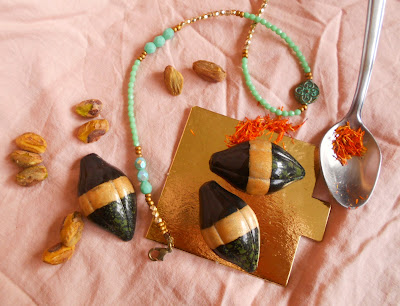Idén valamiért már jó ideje ráhangolódtam a Halloweenre, fene se tudja miért, talán az a borús-őszies egy hét az oka. Minden esetre a hangulathoz megvolt minden, ami kell, és a szuper helyi piacon már több ízben vettünk méretes sütőtököket is, amiket rendre el is pusztítottunk. A legutóbbi alkalommal félretettem egy szelet sütőtököt, abból készültek az alábbi bonbonok. A minta ötlete pedig egy korábbi bonbonomból jött, azonban nemrég az egyik csokis FB csoportban megláttam, hogy valaki ennek épp az inverzét festette meg, és a homlokomra csaptam :D Hiszen a töklámpás lényege épp az, hogy a sötétben világítson! Szóval idén ennek megfelelően készült a festés. Maga a bonbon elkészítése három napot vett igénybe, mivel gyerkőc mellett nem annyira egyszerű ilyen bonyolult műveleteket elvégezni :D Na meg a festés különösen pepecselős volt...
Hozzávalók:
200 gr tejcsoki
50 gr fehércsoki
50 gr sütőtök
65 gr tejszín
fahéj
szerecsendió
gyömbér
ételfesték
Elkészítés:
A sütőtököt puhára sütöm, kikanalazom a héjából. Kimérem a tejszínt, felmelegítem, a beledarabolt tököt villával összenyomkodom. Felolvasztom a fehércsokit, a massszához keverem, majd 2-2 csipetet szórok bele a fűszerekből.
Kifestem a bonbonforma mélyedéseit feketével. Fogpiszkáló segítségével belekarcolom az arcokat. Előkészítek fehér, sárga és vörös ételfestéket, és lángokhoz hasonló mintát festek a töklámpások arcára: alul a fehérrel kezdem, kifelé haladok a sárgával, végül a vörössel, és fogpiszkálóval húzom egymásba a színeket.
Temperálom a tejcsokit, elkészítem a bonbonok burkát. Megtöltöm a sütőtökös krémmel, hűtőbe teszem. Végül temperált tejcsokival lezárom a bonbonokat.
Ingredients:
200 gr milk chocolate
50 gr white chocolate
50 gr pumpkin
65 gr cream
cinnamon
nutmeg
ginger
food paint
Recipe:
I bake the pumpkin and scrape it from its skin. I pour the cream in a small bowl, warm it up and put the diced pumpkin in it. I smash the dices with a fork. I melt the white chocolate, combine it with the mass, then I sprinkle 2-2 pinches of the spices in it.
I cover the cavities of the bonbon mold with black paint. With a toothpick, I carve the faces in it. I prepare white, yellow and red food paints and paint a pattern imitating flames into the jack-o-lanterns' faces: I start with the white in the bottom, then comes the yellow and finally the red. I blend the colors with a toothpick.
I temper the milk chocolate, I prepare the shells. I fill them with the spicy pumpkin cream and place the mold in the fridge. Finally, I seal the bonbons with tempered milk chocolate.








